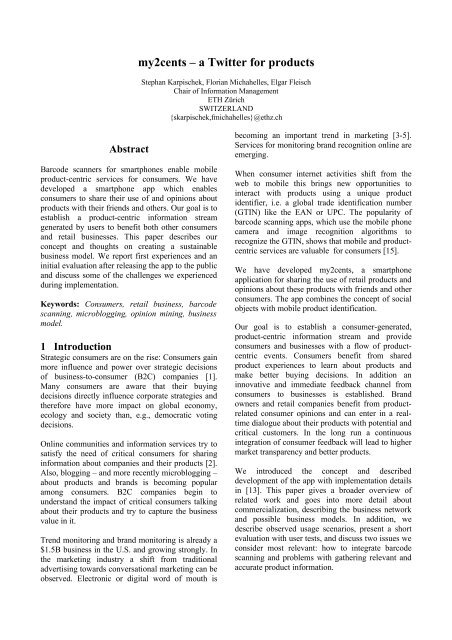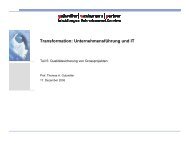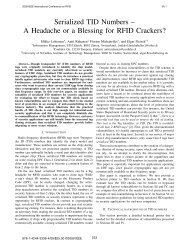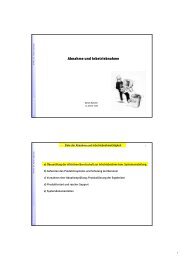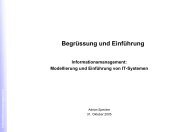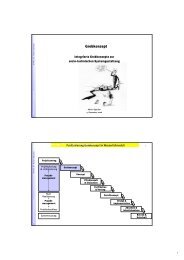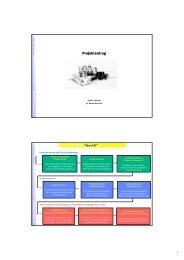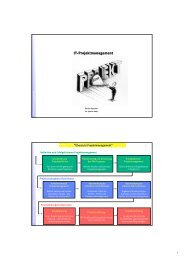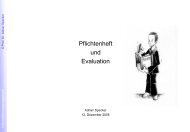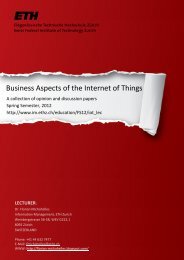my2cents - a Twitter for products - Information Management - ETH ...
my2cents - a Twitter for products - Information Management - ETH ...
my2cents - a Twitter for products - Information Management - ETH ...
Create successful ePaper yourself
Turn your PDF publications into a flip-book with our unique Google optimized e-Paper software.
<strong>my2cents</strong> – a <strong>Twitter</strong> <strong>for</strong> <strong>products</strong><br />
Stephan Karpischek, Florian Michahelles, Elgar Fleisch<br />
Chair of In<strong>for</strong>mation <strong>Management</strong><br />
<strong>ETH</strong> Zürich<br />
SWITZERLAND<br />
{skarpischek,fmichahelles}@ethz.ch<br />
Abstract<br />
Barcode scanners <strong>for</strong> smartphones enable mobile<br />
product-centric services <strong>for</strong> consumers. We have<br />
developed a smartphone app which enables<br />
consumers to share their use of and opinions about<br />
<strong>products</strong> with their friends and others. Our goal is to<br />
establish a product-centric in<strong>for</strong>mation stream<br />
generated by users to benefit both other consumers<br />
and retail businesses. This paper describes our<br />
concept and thoughts on creating a sustainable<br />
business model. We report first experiences and an<br />
initial evaluation after releasing the app to the public<br />
and discuss some of the challenges we experienced<br />
during implementation.<br />
Keywords: Consumers, retail business, barcode<br />
scanning, microblogging, opinion mining, business<br />
model.<br />
1 Introduction<br />
Strategic consumers are on the rise: Consumers gain<br />
more influence and power over strategic decisions<br />
of business-to-consumer (B2C) companies [1].<br />
Many consumers are aware that their buying<br />
decisions directly influence corporate strategies and<br />
there<strong>for</strong>e have more impact on global economy,<br />
ecology and society than, e.g., democratic voting<br />
decisions.<br />
Online communities and in<strong>for</strong>mation services try to<br />
satisfy the need of critical consumers <strong>for</strong> sharing<br />
in<strong>for</strong>mation about companies and their <strong>products</strong> [2].<br />
Also, blogging – and more recently microblogging –<br />
about <strong>products</strong> and brands is becoming popular<br />
among consumers. B2C companies begin to<br />
understand the impact of critical consumers talking<br />
about their <strong>products</strong> and try to capture the business<br />
value in it.<br />
Trend monitoring and brand monitoring is already a<br />
$1.5B business in the U.S. and growing strongly. In<br />
the marketing industry a shift from traditional<br />
advertising towards conversational marketing can be<br />
observed. Electronic or digital word of mouth is<br />
becoming an important trend in marketing [3-5].<br />
Services <strong>for</strong> monitoring brand recognition online are<br />
emerging.<br />
When consumer internet activities shift from the<br />
web to mobile this brings new opportunities to<br />
interact with <strong>products</strong> using a unique product<br />
identifier, i.e. a global trade identification number<br />
(GTIN) like the EAN or UPC. The popularity of<br />
barcode scanning apps, which use the mobile phone<br />
camera and image recognition algorithms to<br />
recognize the GTIN, shows that mobile and productcentric<br />
services are valuable <strong>for</strong> consumers [15].<br />
We have developed <strong>my2cents</strong>, a smartphone<br />
application <strong>for</strong> sharing the use of retail <strong>products</strong> and<br />
opinions about these <strong>products</strong> with friends and other<br />
consumers. The app combines the concept of social<br />
objects with mobile product identification.<br />
Our goal is to establish a consumer-generated,<br />
product-centric in<strong>for</strong>mation stream and provide<br />
consumers and businesses with a flow of productcentric<br />
events. Consumers benefit from shared<br />
product experiences to learn about <strong>products</strong> and<br />
make better buying decisions. In addition an<br />
innovative and immediate feedback channel from<br />
consumers to businesses is established. Brand<br />
owners and retail companies benefit from productrelated<br />
consumer opinions and can enter in a realtime<br />
dialogue about their <strong>products</strong> with potential and<br />
critical customers. In the long run a continuous<br />
integration of consumer feedback will lead to higher<br />
market transparency and better <strong>products</strong>.<br />
We introduced the concept and described<br />
development of the app with implementation details<br />
in [13]. This paper gives a broader overview of<br />
related work and goes into more detail about<br />
commercialization, describing the business network<br />
and possible business models. In addition, we<br />
describe observed usage scenarios, present a short<br />
evaluation with user tests, and discuss two issues we<br />
consider most relevant: how to integrate barcode<br />
scanning and problems with gathering relevant and<br />
accurate product in<strong>for</strong>mation.
2 Related Work<br />
Several popular websites and online communities<br />
target critical consumers: knowmore.org monitors<br />
the social and environmental behavior of consumer<br />
corporations. codecheck.info, Goodguide.com in the<br />
U.S. and das-ist-drin.de in Germany provide<br />
nutritional, ecological or health-related in<strong>for</strong>mation<br />
about food and consumer <strong>products</strong>. The German site<br />
utopia.de offers an online community to connect<br />
critical consumers and earns money providing<br />
consulting services <strong>for</strong> companies who want to<br />
improve their corporate social responsibility.<br />
Carrotmob.org brings together consumers to reward<br />
companies <strong>for</strong> good behavior, a concept they call<br />
reverse boycott.<br />
Blippy is a web community <strong>for</strong> sharing purchases of<br />
goods and services [25]. One purpose of the site is<br />
to facilitate discussion and comparison shopping<br />
among people who are connected with each other<br />
online. Hollrr is a web application that lets users<br />
share favorite brands and <strong>products</strong> via <strong>Twitter</strong> and<br />
Facebook. People seeking guidance while buying a<br />
product can get some valuable in<strong>for</strong>mation [26].<br />
WhosRich.me is a social utility that tracks friends’<br />
shopping habits. Shoppers can show off their new<br />
purchases and receive feedback from their friends.<br />
An iPhone app allows to share events on the go [27].<br />
Migipedia is the web based product community of<br />
Migros, a Swiss retailer. The goal is to feature all<br />
the 40,000 retailers’ <strong>products</strong> and to allow users to<br />
share comments and ratings. Other consumers and<br />
also the retailer can learn about the users’<br />
perceptions of specific <strong>products</strong> [28].<br />
Brody and Gottsman presented a mobile application<br />
<strong>for</strong> comparing prices using the phone's camera to<br />
scan product barcodes in 1999 [6]. Adelmann and<br />
others developed a toolkit <strong>for</strong> recognizing product<br />
barcodes with phone cameras [7]. Novak described a<br />
mobile consumer support system in an augmented<br />
supermarket based on RFID tagged <strong>products</strong> [8].<br />
Resatsch et al. conducted a thorough evaluation of<br />
the user acceptance of mobile product in<strong>for</strong>mation<br />
systems based on RFID [9]. Reischach et al.<br />
developed a mobile product recommendation system<br />
<strong>for</strong> consumers that interacts with NFC tags on<br />
<strong>products</strong> [10]. Reischach et al. have also compared<br />
different product identification techniques [11] and<br />
review modalities <strong>for</strong> mobile phones [12] and<br />
conducted a comparison on mobile barcode scanner<br />
software implementations [17].<br />
ShopSavvy and Compare Everywhere were among<br />
the first applications available <strong>for</strong> the public to offer<br />
mobile barcode scanning on smartphones <strong>for</strong> mobile<br />
price comparison. Both apps initiated as winners of<br />
the first Android app contest in 2008 and build on<br />
the freely available ZXing barcode scanner library<br />
[29-30]. ShopSavvy now has about 5 million users<br />
which generate up to 100.000 scans per day. Red<br />
Laser is a barcode reader app <strong>for</strong> the iPhone which<br />
sold about 2 million apps <strong>for</strong> $2 each and was a long<br />
time top ten paid app on the iTunes App Store. The<br />
app has recently been sold to eBay <strong>for</strong> a reported<br />
price of $10M [31]. Similar apps exist in local<br />
variants <strong>for</strong> Android and iPhone, e.g. barcoo and<br />
woabi in Germany. The Swiss startup Kooaba<br />
developed a system to identify <strong>products</strong> by taking a<br />
picture of the product or the package, a concept<br />
which has also been implemented by Google<br />
Shopper [32-33].<br />
All of these mobile barcode scanning apps focus on<br />
price comparison and cost savings <strong>for</strong> consumers.<br />
More recently apps targeted at critical consumers<br />
have emerged which provide product in<strong>for</strong>mation<br />
about nutrition, health or sustainability: The iPhone<br />
app <strong>for</strong> the Swiss independent product in<strong>for</strong>mation<br />
service codecheck.info immediately gained 100k<br />
downloads in the first days after release [34]. The<br />
comparable app of by Goodguide in the U.S.<br />
Received $3.7M of venture capital funding [35].<br />
ToTem - Tales of Things – allows users to link<br />
memories in the <strong>for</strong>m of digital content to objects<br />
[22]. thinglink started with a similar concept in<br />
2005, providing freely obtainable globally unique<br />
object identifier and a service to link digital content<br />
to this identifier. Their current focus is on<br />
identifying and tagging objects in pictures [23].<br />
StickyBits is a mobile app to stick digital<br />
in<strong>for</strong>mation to barcodes [24]. They sell barcode<br />
stickers to attach to arbitrary objects and have<br />
recently announced a deal with a large retail<br />
company to augment soft drink bottles and cans with<br />
digital content connected to the product's barcode<br />
[36].<br />
Hatena Monolith is a Japanese app offering a gamelike<br />
approach to product scanning: users who scan<br />
product barcodes are rewarded with medals and<br />
virtual money [37]. The location based community<br />
MyTown recently announced to offer product<br />
check-ins together with a large retailer <strong>for</strong> later this<br />
year [38].
Figure 1: General concept: Scan a product's barcode, read what others have said, share your own opinion.<br />
external services <strong>for</strong> product in<strong>for</strong>mation and user<br />
authentication.<br />
3 Our Approach<br />
Most available barcode scanning applications focus<br />
on price comparison answering the question: Where<br />
can I get the scanned product cheaper? Some apps<br />
focus on ingredients and in<strong>for</strong>mation <strong>for</strong> consumers<br />
concerned about health and sustainability, e.g.<br />
goodguide, codecheck, was-ist-drin, etc. In contrast,<br />
the goal of our approach is to make consumers use<br />
smartphones <strong>for</strong> interacting with <strong>products</strong> and social<br />
networks to share their use and opinion about these<br />
<strong>products</strong>. Users should there<strong>for</strong>e be able to quickly<br />
identify a product, access comments and ratings<br />
from friends and other consumers, and post their<br />
own opinion to share it with others.<br />
Scanning a product already indicates that the user is<br />
interested in this product. This is the most basic<br />
<strong>for</strong>m of interaction. Furthermore users can also<br />
share their opinion about a product. This should be<br />
as easy as possible, e.g. after scanning the barcode<br />
one click should suffice to show “I like or dislike<br />
this product”. Writing a text comment on a product<br />
should also be very easy <strong>for</strong> the consumer.<br />
Users should also be able to share their own product<br />
experience with others on microblogging sites and<br />
social networks like <strong>Twitter</strong> or Facebook. Our goal<br />
is to enable dialogues between friends and other<br />
consumers about <strong>products</strong> on the go. This can be<br />
targeted at recommendations and suggestions or also<br />
be only <strong>for</strong> mere satisfaction and fun to express<br />
thoughts about <strong>products</strong> and share them with others.<br />
Posting comments to popular sites also enables us to<br />
include backlinks to the app's website to attract more<br />
users and exploit the viral effect of online social<br />
networks.<br />
Our approach is to implement a basic concept,<br />
distribute the apps, and evaluate usage from server<br />
logs and with user tests to find out more about users'<br />
intentions and expectations. This user-centered<br />
approach helps us to develop closely related to users'<br />
actual needs. We focus on software development<br />
and on providing a great mobile user experience. We<br />
also aim to cooperate with technology partners and<br />
3.1 General Concept<br />
Figure 1 shows the general concept of the<br />
smartphone app: First, users scan a product's<br />
barcode to identify the product. Second, they can see<br />
some basic product in<strong>for</strong>mation to confirm the<br />
correct identification of the product and see what<br />
their friends and others think about the product. If<br />
others have left comments, they can also read these<br />
comments. Third, users can state their own opinion,<br />
either by pressing a like or dislike button, or by<br />
entering a short text comment. Users can identify<br />
themselves using an existing social network account.<br />
Comments can also be shared with others by<br />
distributing them on social networks or<br />
microblogging sites.<br />
3.2 Features<br />
The mobile application uses the smartphone’s<br />
camera to read the product’s barcode and capture the<br />
product’s GTIN. This GTIN is used to query a web<br />
service <strong>for</strong> in<strong>for</strong>mation related to the product. The<br />
web service queries an internal database and several<br />
external resources <strong>for</strong> basic product in<strong>for</strong>mation<br />
(e.g. name, manufacturer and image) which can be<br />
returned to the mobile app to confirm the correct<br />
identification of the product <strong>for</strong> the user. If<br />
comments and ratings from other users <strong>for</strong> the<br />
identified product are available, these are returned as<br />
well.<br />
Successful barcode scanning is subject to lighting<br />
conditions and the surface of the package where the<br />
barcode is printed. When scanning fails, users can<br />
also enter the product's barcode number by typing<br />
the numbers of the barcode number.<br />
For a scanned product users can read other users<br />
comments and see the overall rating <strong>for</strong> a product.<br />
They can rate a product with a binary rating by<br />
simply clicking one of two buttons showing thumbs<br />
up or thumbs down. Users can also enter and submit<br />
a textual comment <strong>for</strong> a product.
identify the product. We also rely on external<br />
services to authenticate users.<br />
Figure 2: Business network.<br />
Users can login with an existing account <strong>for</strong> a social<br />
network, e.g. <strong>Twitter</strong> or Facebook. When logged in<br />
comments are not posted anonymously but are<br />
mapped to the account's profile and displayed with<br />
the user's name and avatar image. Users can also<br />
choose to post their comments to their social<br />
network or microblogging site. When doing so, a<br />
backlink to the app's web page showing the product<br />
and all related comments is added to the comment.<br />
On the website and from within the mobile app<br />
users can follow a live stream of comments<br />
submitted by other users. Logged in users can<br />
highlight comments by friends and peers. Clicking<br />
on comments shows the product with all related<br />
comments, clicking on a username shows a list of<br />
<strong>products</strong> a user has scanned, likes or dislikes, or has<br />
commented on. Product categories allow a browsing<br />
through related <strong>products</strong>.<br />
A history feature in the mobile app allows users to<br />
see a list of the <strong>products</strong> they have scanned or<br />
visited be<strong>for</strong>e. Users can also choose to receive<br />
notifications when others are commenting on<br />
<strong>products</strong> they have previously commented on. This<br />
notification can be done via email, text message,<br />
direct message on the social network, or push<br />
notifications to the smartphone.<br />
3.3 Implementation<br />
Figure 2 shows the business network in which we<br />
implement the proposed concept. The core of our<br />
own business is software development and data<br />
analysis: We develop the mobile applications <strong>for</strong> the<br />
consumers and <strong>for</strong> different smartphone operating<br />
systems. We also develop the server back end, do<br />
the data analysis and generate reports and<br />
visualizations from the consumer-generated<br />
in<strong>for</strong>mation stream <strong>for</strong> business customers.<br />
External partners provide the barcode scanning<br />
technology and the product in<strong>for</strong>mation needed to<br />
3.3.1 Barcode scanning<br />
Several different libraries <strong>for</strong> barcode scanning<br />
exist. On Android we use the freely available ZXing<br />
barcode scanner library <strong>for</strong> product identification<br />
[30]. On the iPhone have first used the RedLaser<br />
barcode scanning library but replaced it later with<br />
ScanDK, a better and faster barcode scanning<br />
solution developed by Mirasense, a Swiss startup<br />
[39]. Another interesting option is the open source<br />
library Zbar, which implements a cross-plat<strong>for</strong>m<br />
barcode reader [40].<br />
3.3.2 Product in<strong>for</strong>mation<br />
Basic product in<strong>for</strong>mation (i.e. the name, image,<br />
category, and manufacturer of the product) is<br />
retrieved from various online sources to enable<br />
product identification <strong>for</strong> the user. Our goal is to<br />
provide a fast and accurate response and to<br />
recognize as many retail <strong>products</strong> with a barcode as<br />
possible. As there is no authoritative source of<br />
product in<strong>for</strong>mation <strong>for</strong> retail <strong>products</strong>, we use<br />
several different databases and web services to<br />
retrieve product in<strong>for</strong>mation, e.g. Amazon<br />
eCommerce web service, codecheck.info, UPC<br />
database, OpenEAN database, affili.net. The<br />
in<strong>for</strong>mation is aggregated and we try to provide the<br />
most accurate product in<strong>for</strong>mation <strong>for</strong> the user.<br />
Currently, we are ordering the in<strong>for</strong>mation sources<br />
by reliability in a very static way, i.e. just by looking<br />
at the data returned <strong>for</strong> selected <strong>products</strong>. We are<br />
working on implementing a user feedback system to<br />
measure and automatically adjust the reliability of<br />
in<strong>for</strong>mation sources and – if necessary – to make the<br />
users correct a wrong product in<strong>for</strong>mation or add<br />
missing in<strong>for</strong>mation <strong>for</strong> an unknown product.<br />
3.3.3 User authentication<br />
We use external services as identity providers. Users<br />
can authenticate using existing accounts, e.g.,<br />
<strong>Twitter</strong> or Facebook. Other communities and<br />
services can be integrated easily.<br />
The accounts and services used <strong>for</strong> authentication<br />
can also be used to distribute user contributions and<br />
benefit from viral effects, making scanned <strong>products</strong><br />
and also the app more popular.<br />
3.3.4 Software development<br />
The application consists of a web service and<br />
several mobile client apps. The server backend has<br />
been implemented using the Ruby on Rails web
compared to the stream provided by <strong>Twitter</strong> and<br />
other microblogging systems or social networks.<br />
The app should always be free <strong>for</strong> consumers.<br />
Economically sustainable operation of the service<br />
needs to generate some revenue. However, the app<br />
should also provide independent and trusted product<br />
in<strong>for</strong>mation.<br />
We discussed different business models with<br />
representatives from retail companies and brand<br />
owners, consumer communities and venture capital<br />
firms. From this process we have identified several<br />
options to generate revenue from a consumergenerated,<br />
product-centric in<strong>for</strong>mation stream:<br />
Figure 3: Screenshots of the Android app.<br />
Figure 4: Using the Android app.<br />
programming framework. It provides a RESTful<br />
API to access product in<strong>for</strong>mation and to access and<br />
post user comments and ratings.<br />
The backend also provides a simple web interface<br />
which can be used with standard web browsers and<br />
also a lot of mobile web browsers.<br />
The smartphone app has been developed <strong>for</strong><br />
Android and iPhone plat<strong>for</strong>ms. The first version of<br />
the app has been released on the Android market in<br />
April 2010. Figure 3 shows some screenshots of the<br />
Android app. Figure 4 shows pictures of using the<br />
app with a product. The iPhone release is planned<br />
<strong>for</strong> the next month. The current status of the app and<br />
consumer comments can be seen on the app's<br />
website. 1<br />
4 Business Model<br />
The usage of the app results in a user-generated,<br />
product-centric in<strong>for</strong>mation stream which can be<br />
1 http://<strong>my2cents</strong>.mobi<br />
4.1 Product-Centric CRM<br />
Available geo-location in<strong>for</strong>mation in mobile<br />
phones has been an important driver <strong>for</strong> pervasive<br />
computing with a wide range of location-based<br />
services becoming popular on smartphones. Some<br />
location based services like plazes, Foursquare,<br />
GoWalla or Friendticker in Germany, have shown<br />
that people like to socialize around specific locations<br />
like, e.g. restaurants, bars, etc. With these apps users<br />
can “check in” with specific locations and distribute<br />
events and comments related to these locations to<br />
their social networks letting their friends know<br />
where they are and what they think about a place.<br />
With simple product identification <strong>for</strong> smartphones,<br />
this concept can be transferred to retail <strong>products</strong>.<br />
Businesses can benefit from this approach to<br />
implement a social customer relationship<br />
management system around their <strong>products</strong> at low<br />
costs. Brand owners and retailers could get in<br />
contact with customers interested in their <strong>products</strong> in<br />
real-time and be charged <strong>for</strong> a privileged access to<br />
consumers and their opinions. A comparable<br />
business model <strong>for</strong> business locations has been<br />
implemented by the Berlin based startup<br />
Friendticker [22].<br />
4.2 Marketing<br />
All comments on a specific brand or a collection of<br />
<strong>products</strong> can be collected and provided to the brand<br />
owner as consumer feedback <strong>for</strong> marketing, e.g. as<br />
advertising content <strong>for</strong> digital signage at the point of<br />
sale.<br />
Given the user comments are not anonymous but<br />
related to a social network profile with a username<br />
and avatar image, user comments can also make<br />
very valuable user testimonials in marketing<br />
campaigns.
specific product and is probably interested in<br />
comparable <strong>products</strong> or cross-selling. According to<br />
mobile marketing experts a price <strong>for</strong> thousand ad<br />
views (CPM) of $10-15 is realistic. Additional<br />
revenue can be generated with affiliate links.<br />
ShopSavvy introduced a product-centric advertising<br />
plat<strong>for</strong>m in early 2010. With 5M users of their own<br />
app and over 100 licensees of their barcode scanning<br />
framework they hope to generate about 10M product<br />
scans per day [31].<br />
Figure 5: White label app examples.<br />
4.3 Market Research<br />
Brand owners have a strong interest to know more<br />
about the perception of their brand. The steering of<br />
the brand image and the resulting brand recognition<br />
are activities strongly related to marketing and<br />
subject to extensive market research. The market <strong>for</strong><br />
behavioral studies and brand tracking is expected to<br />
reach $1.5B in 2010 [21].<br />
Comments and user opinions about <strong>products</strong> can be<br />
used <strong>for</strong> market research, trend analysis and brand<br />
tracking [3-5]. Consumer behavior and feedback can<br />
be monitored in real-time and location-based,<br />
providing valuable input <strong>for</strong> strategic decisions.<br />
Reactions to events and other external factors<br />
affecting consumer opinions can be monitored.<br />
Opinion mining and sentiment analysis can be used<br />
to automatically derive a measurement <strong>for</strong><br />
consumer's perception of certain <strong>products</strong> [18-19].<br />
As consumers authenticate themselves using<br />
existing social network accounts to personalize their<br />
comments and share them precise consumer<br />
profiling <strong>for</strong> market research is possible – given of<br />
course that privacy considerations allow access to<br />
consumer profiles.<br />
4.4 Advertising<br />
With acquisitions of AdMob by Google and the<br />
introduction of iAd by Apple the market <strong>for</strong> mobile<br />
advertising is estimated to reach $1B soon and is<br />
growing fast [16].<br />
The proposed system can be used <strong>for</strong> heavily<br />
targeted advertising in the retail business: When<br />
scanning a product, the user shows interest in this<br />
4.5 White Label<br />
If not operated as an independent service the app can<br />
also be licensed to and customized <strong>for</strong> existing<br />
consumer communities, opinion sites with product<br />
databases, or brand owners and retail companies.<br />
Figure 5 shows two examples <strong>for</strong> customized apps.<br />
The customized app carries the corporate identity of<br />
the customer and is also distributed in the<br />
customer‘s name through app stores or can be<br />
downloaded from the customer‘s website. The<br />
customer provides and has complete control over the<br />
available and presented product in<strong>for</strong>mation when<br />
scanning the customer‘s <strong>products</strong>. Also, the<br />
processing and distribution of consumer comments<br />
can be controlled by the customer. Consumer<br />
comments collected by the app can be used <strong>for</strong><br />
advertising, e.g. with digital signage at the point of<br />
sale, as testimonials in marketing campaigns, or<br />
analyzed <strong>for</strong> market research.<br />
The core benefits <strong>for</strong> business customers are:<br />
• Costs <strong>for</strong> market research are reduced: According<br />
to marketing experts, in traditional market research a<br />
consumer survey costs about $10 per person. The<br />
app can provide one consumer‘s opinion at an<br />
estimated $0.5 resulting in a cost reduction of 95%. 2<br />
• Tracking of brand recognition and consumer<br />
trends, sentiment analysis, and conversational<br />
marketing are enabled at low costs.<br />
• The brand is present in mobile and social media<br />
with a tangible added value <strong>for</strong> the business.<br />
• Cross selling mobile advertising and coupons<br />
within one brand are possible: During a scanning<br />
process at the point of sale advertising <strong>for</strong> a related<br />
product can be displayed on the phone. (e.g. if a<br />
consumer scans cereals he/she gets an advertising<br />
message <strong>for</strong> yogurt on his phone. This could also be<br />
2 Calculation based on an app<br />
generating 250 user comments per<br />
day and running <strong>for</strong> three years
combined with a digital coupon, which can be<br />
redeemed at the check-out right away).<br />
• Large retailers can use the app to supplement<br />
existing loyalty schemes, e.g. customer loyalty cards<br />
or collecting points <strong>for</strong> shopping.<br />
5 Evaluation<br />
5.1 User Adoption<br />
Since the release of the Android version on 23 April<br />
2010 the app was installed 2.370 times with about<br />
30% active installs. Users generated 39.649 product<br />
requests on the server backend <strong>for</strong> 6.269 different<br />
<strong>products</strong> and left 1.726 comments of which 671 or<br />
38.9% came from authenticated users. 3<br />
5.2 User Feedback<br />
Android users have rated the app 37 times with an<br />
average rating of 3.65 corresponding to 3.5 out of 5<br />
stars. The app has received 19 comments from<br />
users: 12 in the English Android market, and 7 in<br />
the German Android market. While German<br />
comments are rather positive the English comments<br />
are more diverse. Many users suggested features and<br />
improvements of which some will be considered in<br />
the next development iterations.<br />
5.3 Usage Scenarios<br />
From the user activity and feedback we could derive<br />
the following dominant usage scenarios:<br />
• Communicate product experience either during or<br />
directly after a product use.<br />
• Express yourself, describe yourself by what<br />
product you use or want to have.<br />
• Receive in<strong>for</strong>mation about a product while or<br />
be<strong>for</strong>e buying it a the point of sale.<br />
• Ask questions about <strong>products</strong> of interest.<br />
• Reply to comments or chat about <strong>products</strong> other<br />
users have commented on.<br />
5.4 Usability Tests<br />
In order to find problems with the usability of the<br />
mobile apps and the website we conducted tests with<br />
a few users following a do-it-yourself approach to<br />
finding and fixing usability problems as proposed by<br />
[12]. The tests were not meant as a user study.<br />
Instead, the only goal of these usability tests was to<br />
get feedback on our implementation of the user<br />
interface answering questions like: Is the app easy to<br />
use? Can users achieve relevant goals when using<br />
the app, e.g., give a comment on a product?<br />
We invited three users who had never used the app<br />
be<strong>for</strong>e. The users were selected using postings on<br />
craigslist, <strong>Twitter</strong> and Facebook and paid <strong>for</strong> their<br />
ef<strong>for</strong>t. The only condition was that they owned<br />
either an Android phone or an iPhone.<br />
The users were presented with a user posting a<br />
product comment on <strong>Twitter</strong> including a link back to<br />
the app's website. They were asked to visit the<br />
website, install the app, and work on several tasks.<br />
Users were asked to talk out loud what they were<br />
thinking during usage of the app. The phone screen<br />
was filmed with a camera mounted on a flexible<br />
rack which could be hold together with the<br />
smartphone so that the screen was always visible.<br />
Video and audio were recorded and transmitted to<br />
an observer room where the development team was<br />
watching and listening to the users working on the<br />
tasks.<br />
In the tests we learned about several problems with<br />
our implementation of the iPhone user interface. For<br />
example we found out that users often logged out<br />
accidentally right after logging in because of<br />
misleading options on the screen. Also the mobile<br />
app seemed not to be easy tofind on the website. The<br />
observed problems were fixed be<strong>for</strong>e the release of<br />
the iPhone app and we are planning to repeat the<br />
user tests on a regular basis.<br />
6 Discussion<br />
6.1 Barcode Scanning<br />
Recent advances to better recognition algorithms<br />
and improvements in resolution, speed and quality<br />
of smartphone cameras, barcode scanning with<br />
phones is still a cumbersome and error-prone<br />
process. We have found that the last generation of<br />
barcode recognition software provides a near 100%<br />
accuracy. However, some users still experience<br />
problems under certain circumstances.<br />
From a user perspective instead of scanning the<br />
same barcode many times with different applications<br />
to get different types of product in<strong>for</strong>mation it<br />
probably makes more sense to scan a barcode only<br />
once and then use several different in<strong>for</strong>mation<br />
services <strong>for</strong> the same product, e.g. first receive a<br />
price comparison, then recommendations from<br />
friends, reviews from experts, and finally where to<br />
get the product nearby.<br />
3 Numbers from the Android market<br />
statistics 29 July 2010.
In the future, the functionality of scanning a barcode<br />
will eventually go down to the level of the<br />
smartphone operating system, i.e. the operating<br />
system providing barcode scanning events <strong>for</strong><br />
applications comparable to providing location<br />
in<strong>for</strong>mation <strong>for</strong> applications now.<br />
6.2 Product In<strong>for</strong>mation<br />
Of the 6.269 <strong>products</strong> 48% (2985) could be<br />
identified, i.e. one of the product in<strong>for</strong>mation<br />
services returned a product name <strong>for</strong> the requested<br />
GTIN. 26% of the <strong>products</strong> which were identified<br />
have received comments from users compared to<br />
only 11% of those <strong>products</strong> which could not be<br />
recognized. A reliable and correct identification of<br />
the product seems to improve the rate of user<br />
contributions.<br />
Accuracy of product in<strong>for</strong>mation varies a lot over<br />
different product in<strong>for</strong>mation sources, countries and<br />
product categories, e.g., in<strong>for</strong>mation from Amazon<br />
is very accurate <strong>for</strong> books and other media, but often<br />
provides wrong results <strong>for</strong> groceries in Europe.<br />
Furthermore, Amazon's terms of service do not<br />
allow the use of content “in connection with any site<br />
or application designed or intended <strong>for</strong> use with a<br />
mobile device” without an explicit approval [20].<br />
We have asked Amazon <strong>for</strong> an approval but never<br />
received any answer.<br />
In contrast product in<strong>for</strong>mation from codecheck.info<br />
has proven to be very accurate <strong>for</strong> groceries in the<br />
German speaking market. User comments and<br />
ratings from the different Android markets indicate<br />
that the app is perceived to per<strong>for</strong>m better in<br />
German speaking countries.<br />
While some retail companies provide their product<br />
catalogs, e.g. <strong>for</strong> download or via affiliate networks,<br />
other databases such as the ones of some retailers or<br />
data pools following the GS1 global data<br />
synchronization network standard are not yet<br />
accessible or only at high costs. Many large<br />
companies and organizations still regard even very<br />
basic product in<strong>for</strong>mation as proprietary and <strong>for</strong><br />
internal supply-chain operations only. We believe<br />
that with mobile product in<strong>for</strong>mation services the<br />
availability of basic product in<strong>for</strong>mation will make a<br />
difference in how consumers perceive a brand and<br />
its <strong>products</strong>.<br />
6.3 Conclusions and Outlook<br />
Our vision is to establish a consumer-generated,<br />
product-centric in<strong>for</strong>mation stream <strong>for</strong> a wide range<br />
of <strong>products</strong>. We want to implement a sustainable,<br />
consumer-friendly and transparent business model<br />
based on this in<strong>for</strong>mation stream.<br />
We have discussed the opportunities of a <strong>Twitter</strong> <strong>for</strong><br />
<strong>products</strong> and the benefits <strong>for</strong> both consumers and<br />
businesses. We believe that the success of social<br />
services around locations can be successfully<br />
transferred to <strong>products</strong>. We have shown our<br />
approach to an implementation and described<br />
several possible revenue streams.<br />
We believe that mobile phones will enable consumer<br />
interactions with <strong>products</strong> and that these interactions<br />
will improve the quality of life: Consumers will<br />
finally get the <strong>products</strong> they want, after businesses<br />
listened to their feedback <strong>for</strong> years and improved the<br />
<strong>products</strong> to reach a higher level of customer<br />
satisfaction.<br />
Besides further improvements on the usability of the<br />
app and better product recognition we also want to<br />
analyse the collected data. Interesting questions<br />
include:<br />
• Which <strong>products</strong> and product<br />
categories are most commented on?<br />
• Which <strong>products</strong> and product-related<br />
topics are currently trending?<br />
• Does it make sense to apply<br />
collaborative filtering techniques (users<br />
who liked this product also liked …)?<br />
• Can we measure consumer<br />
reactions to marketing ef<strong>for</strong>ts, e.g.<br />
advertising campaigns?<br />
• Can we recognize negative<br />
opinions and trends like low consumer<br />
satisfaction or quality problems with<br />
<strong>products</strong>?<br />
Our long-term goal is to derive an instant market<br />
research tool: what do people in region x currently<br />
think about product y?<br />
Acknowledgements<br />
The authors would like to thank the <strong>my2cents</strong><br />
development team: Tilmann Singer, Nadine Gahr,<br />
Yan Minagawa, Anton Rau, Mike Godenzi, Claudio<br />
Mar<strong>for</strong>io, and Stefan Hradetzky. We also want to<br />
thank the people behind Mirasense and<br />
codecheck.info <strong>for</strong> their support and the reviewers<br />
<strong>for</strong> their valuable feedback.
References<br />
[1] G. P. Cachon and R. Swinney, Purchasing,<br />
Pricing, and Quick Response in the Presence of<br />
Strategic Consumers. <strong>Management</strong> Science, Vol.<br />
55, No. 3, March 2009, pp. 497-511.<br />
[2] E.L. Lesser, M.A. Fontaine, and J.A. Slusher,<br />
Knowledge and communities, Butterworth-<br />
Heinemann, 2000.<br />
[3] C. Dellarocas, The digitization of word of<br />
mouth: Promise and challenges of online<br />
feedback mechanisms, <strong>Management</strong> Science,<br />
vol. 49, October 2003, pp. 1407-1424.<br />
[4] B. Jansen, M. Zhang, K. Sobel, and A.<br />
Chowdury, <strong>Twitter</strong> power: Tweets as electronic<br />
word of mouth, Journal of the American Society<br />
<strong>for</strong> In<strong>for</strong>mation Science and Technology, vol.<br />
60, 2009, pp. 2169-2188.<br />
[5] P. Dwyer, Measuring the value of electronic<br />
word of mouth and its impact in consumer<br />
communities, Journal of Interactive Marketing,<br />
vol. 21, no. 2, 2007, pp. 63–79.<br />
[6] A. B. Brody and E. J. Gottsman, Pocket bargain<br />
finder: A handheld device <strong>for</strong> augmented<br />
commerce, in HUC ’99: Proceedings of the 1st<br />
international symposium on Handheld and<br />
Ubiquitous Computing. London, UK: Springer-<br />
Verlag, 1999, pp. 44–51.<br />
[7] R. Adelmann, M. Langheinrich, C.<br />
Floerkemeier, A Toolkit <strong>for</strong> Bar-Code-<br />
Recognition and -Resolving on Camera Phones –<br />
Jump Starting the Internet of Things.<br />
Proceedings of the workshop on Mobile and<br />
Embedded Interactive Systems (MEIS'06) at<br />
In<strong>for</strong>matik 2006. Dresden, Germany, October<br />
2006.<br />
[8] J. Novak, Ubiquitous computing and socially<br />
aware consumer support systems in the<br />
augmented supermarket, in Workshop on Social<br />
Implications of Ubiquitous Computing at CHI<br />
2005 (UbiSoc 2005), Portland, Oregon, US,<br />
2005.<br />
[9] F. Resatsch, U. Sandner, J. M. Leimeister, and<br />
H. Krcmar, Do point of sale RFID-Based<br />
in<strong>for</strong>mation services make a difference?<br />
Analyzing consumer perceptions <strong>for</strong> designing<br />
smart product in<strong>for</strong>mation services in retail<br />
business, Electronic Markets, vol. 18, no. 3, pp.<br />
216–231, 2008.<br />
[10] F. von Reischach, D. Guinard, F. Michahelles,<br />
and E. Fleisch, A mobile product<br />
recommendation system interacting with tagged<br />
<strong>products</strong>, in PERCOM ’09: Proceedings of the<br />
2009 IEEE International Conference on<br />
Pervasive Computing and Communications.<br />
Washington, DC, USA: IEEE Computer Society,<br />
2009, pp. 1–6.<br />
[11] F. von Reischach, F. Michahelles, D. Guinard,<br />
R. Adelmann, E. Fleisch, and A. Schmidt, An<br />
evaluation of product identification techniques<br />
<strong>for</strong> mobile phones, in Proceedings of the 12th<br />
IFIP TC13 Conference in Human-Computer<br />
Interaction (Interact’09), August 2009, pp. 804–<br />
816.<br />
[12] S. Krug, Rocket Surgery Made Easy: The Do-<br />
It-Yourself Guide to Finding and Fixing<br />
Usability Problems, New Riders Press, 2009.<br />
[13] S. Karpischek, F. Michahelles, <strong>my2cents</strong> -<br />
Digitizing consumer opinions and comments<br />
about retail <strong>products</strong>. Internet of Things 2010<br />
Conference (IoT2010), Tokyo, Japan, November<br />
– December 2010.<br />
[14] K. Leder, A. Karpovich, M. Burke, C. Speed,<br />
A. Hudson-Smith, S. O’Callaghan, M. Simpson,<br />
R. Barthel, B. Blundell, M. D. Jode, C. Lee, A.<br />
Manohar, D. Shingleton, and J. Macdonald,<br />
Tagging is connecting: Shared object memories<br />
as channels <strong>for</strong> sociocultural cohesion, M/C<br />
Journal, vol. 13, no. 1, 2010.<br />
http://journal.mediaculture.org.au/index.php/mcjournal/article/view/<br />
209 .<br />
[15] GS1, Mobile Commerce: opportunities and<br />
challenges – a GS1 Mobile Com White Paper,<br />
February 2008.<br />
[16] N. Elkin, Mobile Advertising and Marketing:<br />
Change Is in the Air, eMarketer report,<br />
September 2009,<br />
http://www.emarketer.com/Reports/All/Emarket<br />
er_2000591.aspx .<br />
[17] F. von Reischach, S. Karpischek, R.<br />
Adelmann, F. Michahelles, Evaluation of 1D<br />
barcode scanning on mobile phones, Internet of<br />
Things 2010 Conference, Tokyo, Japan.<br />
[18] B. Pang and L. Lee, Opinion Mining and<br />
Sentiment Analysis, Foundations and Trends in<br />
In<strong>for</strong>mation Retrieval, vol. 2, 2008, pp. 1-135.<br />
[19] D. Lee, O. Jeong, and S. Lee, Opinion mining<br />
of customer feedback data on the web,<br />
Proceedings of the 2nd international conference<br />
on Ubiquitous in<strong>for</strong>mation management and<br />
communication, Suwon, Korea: ACM, 2008, pp.<br />
230-235.<br />
[20] Amazon Associates Programme Participation<br />
Requirements,<br />
https://partnernet.amazon.de/gp/associates/prom<br />
o/participationrequirements .<br />
[21] http://insideresearch.com .
[22] http://techcrunch.com/2010/04/12/germanysfriendticker-recycles-foursquare-but-with-a-realcrm-backend/<br />
.<br />
[23] thinglink, http://www.thinglink.org .<br />
[24] stickybits - tag your world,<br />
http://www.stickybits.com .<br />
[25] blippy - what are your friends buying?,<br />
http://www.blippy.com.<br />
[26] hollrr - shout about the things you love,<br />
http://www.hollrr.com.<br />
[27] Whosrich - home <strong>for</strong> social shopping,<br />
http://www.www.whosrich.me.<br />
[28] Migipedia, http://beta.migipedia.ch/de/.<br />
[29] Android Developer Contest I Top 50 Gallery,<br />
http://code.google.com/android/adc/adc_gallery/.<br />
[30] zxing, http://code.google.com/p/zxing/.<br />
[31] http://www.biggu.com/2010/06/29/what-thesale-of-red-laser-means-<strong>for</strong>-shopsavvy/.<br />
[32] kooaba, http://www.kooaba.com/.<br />
[33] Google Shopper,<br />
http://www.google.com/mobile/shopper/ .<br />
[34] codecheck.info, http://www.codecheck.info .<br />
[35] http://venturebeat.com/2009/01/19/goodguideraises-373m-<strong>for</strong>-ethical-shopping/<br />
.<br />
[36] http://techcrunch.com/2010/06/07/stickybitspepsi/<br />
.<br />
[37] http://mono.hatena.com/ .<br />
[38] http://venturebeat.com/2010/07/26/booyahproduct-check-in/<br />
.<br />
[39] Mirasense ScanDK,<br />
http://www.mirasense.com/ .<br />
[40] http://zbar.source<strong>for</strong>ge.net/ .


